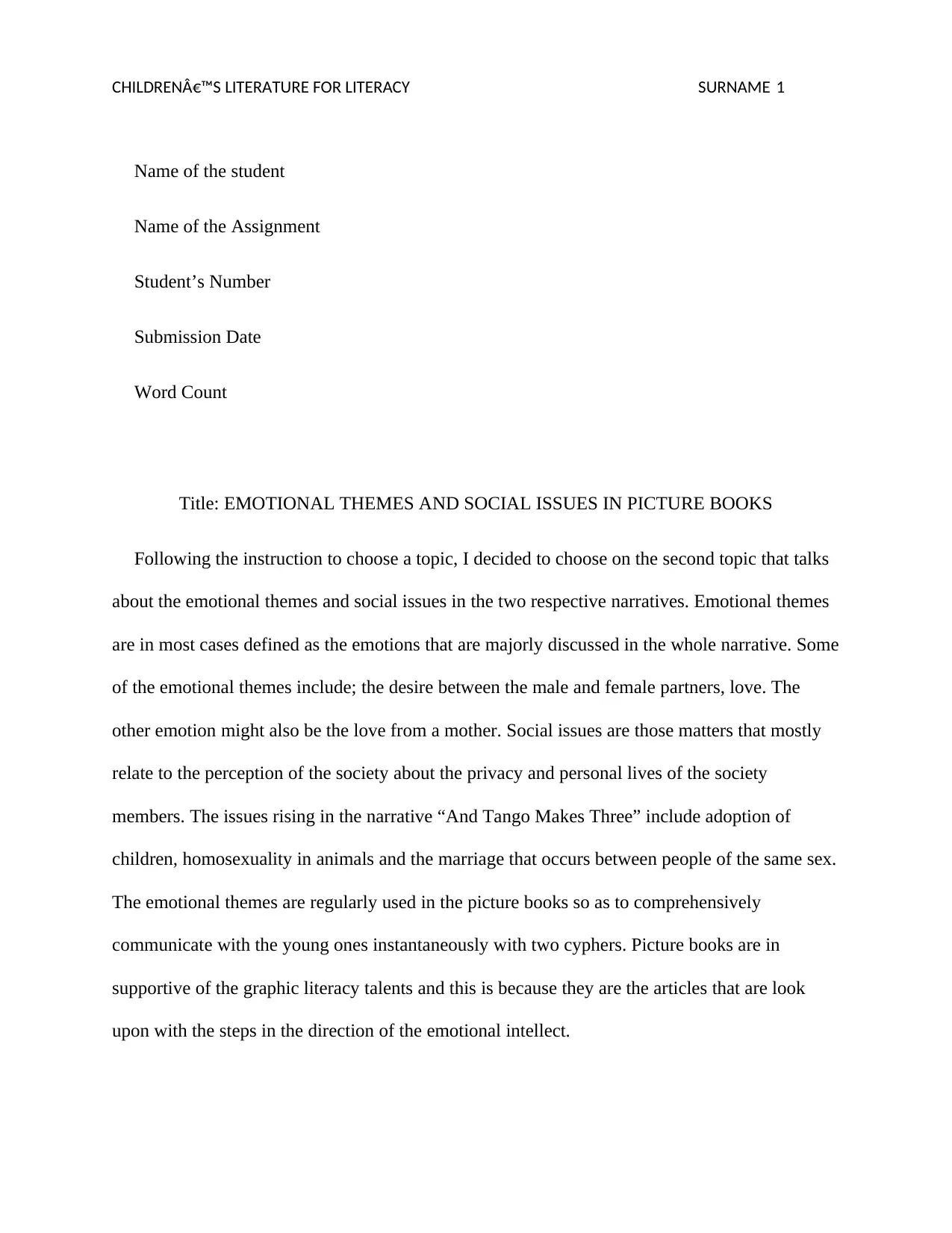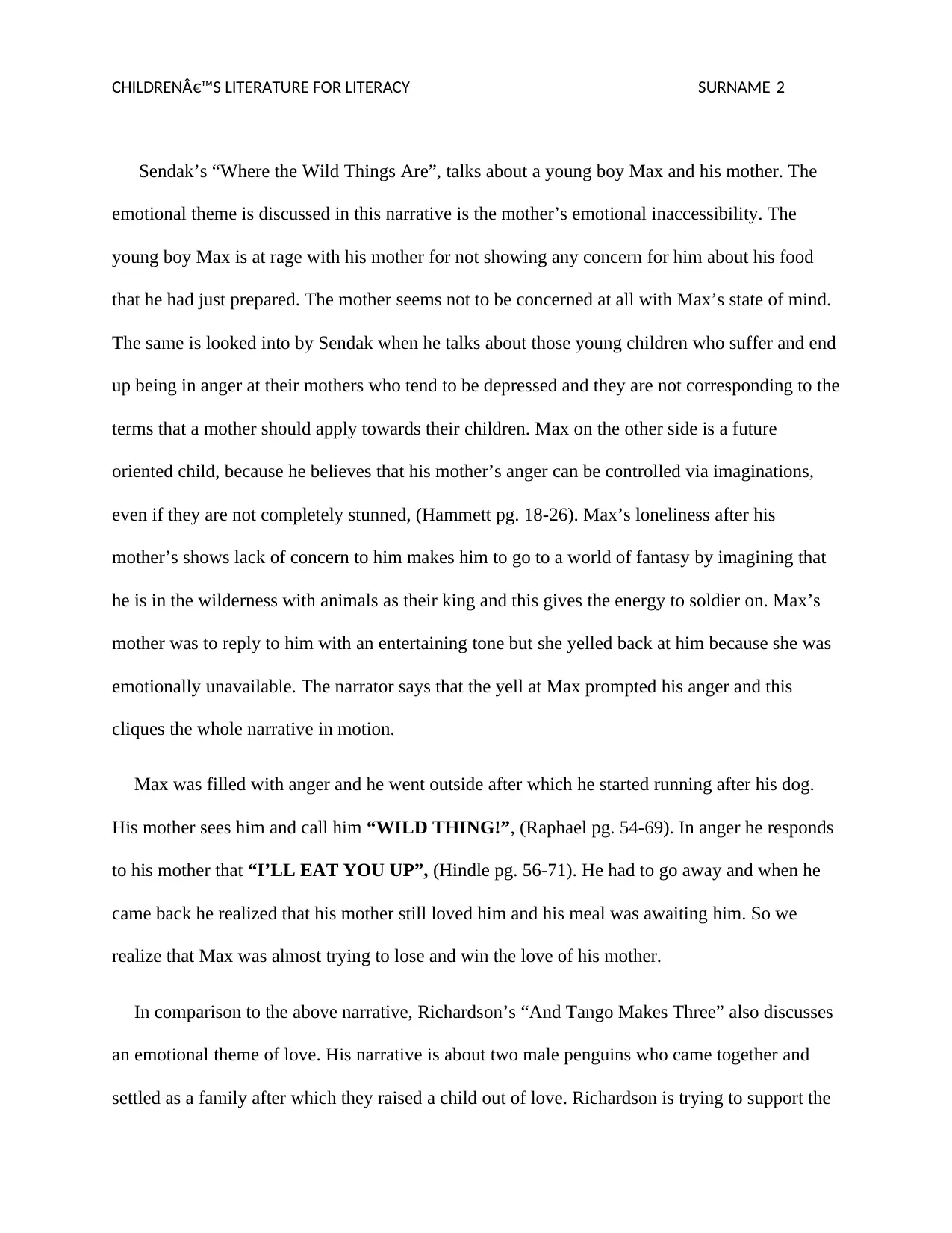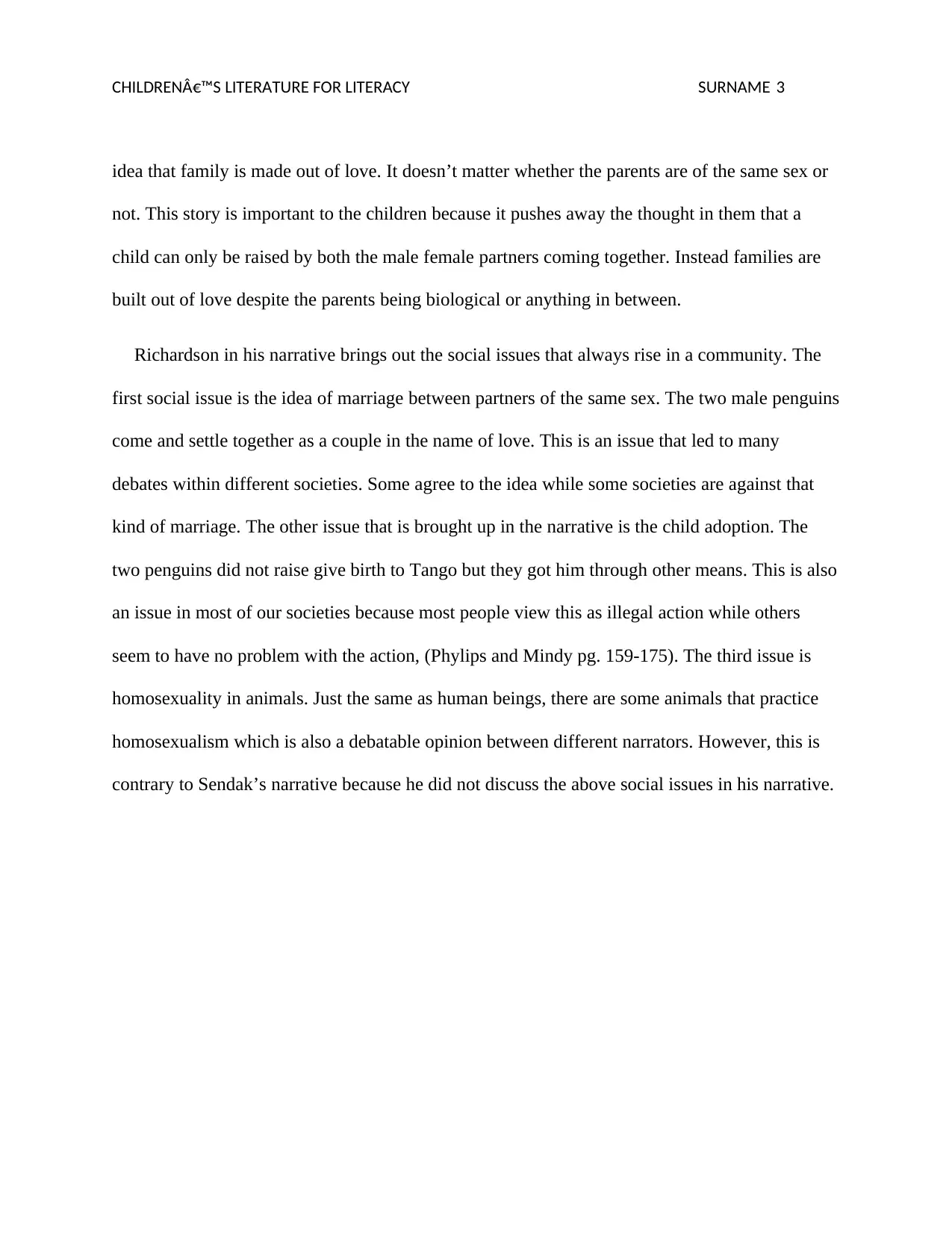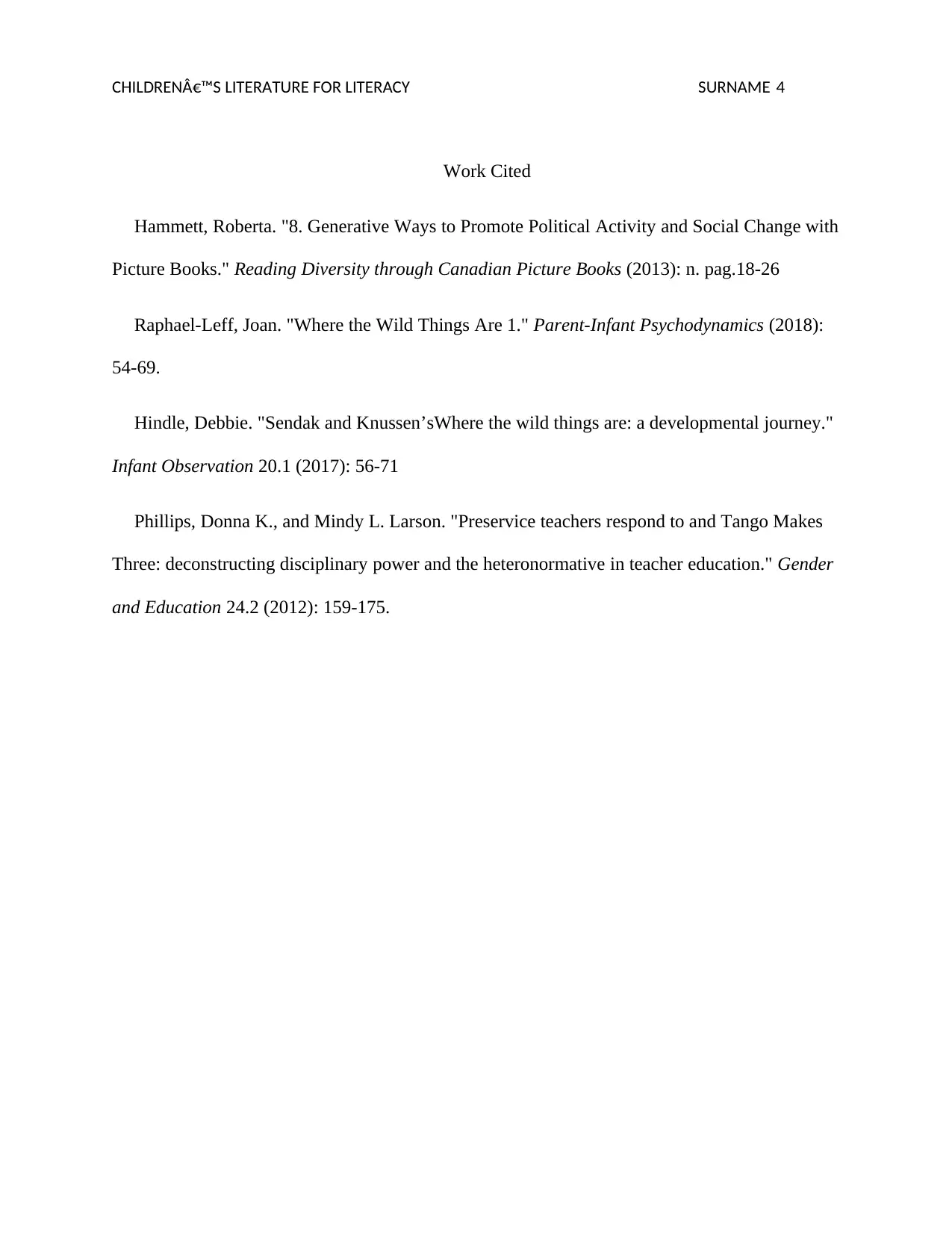EAC273: Emotional Themes and Social Issues in Picture Book Analysis
VerifiedAdded on 2022/09/18
|4
|1046
|31
Essay
AI Summary
This essay examines emotional themes and social issues in two children's picture books: 'And Tango Makes Three' and 'Where the Wild Things Are'. The essay begins by defining emotional themes and social issues and then delves into the narratives. 'Where the Wild Things Are' explores the emotional inaccessibility of a mother and the resulting anger and loneliness of a young boy named Max, who escapes into a world of fantasy. 'And Tango Makes Three' focuses on the theme of love, specifically the formation of a family through adoption by two male penguins, and addresses social issues such as same-sex marriage and adoption. The essay highlights the authors' approaches to conveying these themes and issues, noting the contrasting perspectives of the two narratives and their implications for young readers. The essay also references relevant academic sources to support its analysis.

CHILDREN€™S LITERATURE FOR LITERACY SURNAME 1
Name of the student
Name of the Assignment
Student’s Number
Submission Date
Word Count
Title: EMOTIONAL THEMES AND SOCIAL ISSUES IN PICTURE BOOKS
Following the instruction to choose a topic, I decided to choose on the second topic that talks
about the emotional themes and social issues in the two respective narratives. Emotional themes
are in most cases defined as the emotions that are majorly discussed in the whole narrative. Some
of the emotional themes include; the desire between the male and female partners, love. The
other emotion might also be the love from a mother. Social issues are those matters that mostly
relate to the perception of the society about the privacy and personal lives of the society
members. The issues rising in the narrative “And Tango Makes Three” include adoption of
children, homosexuality in animals and the marriage that occurs between people of the same sex.
The emotional themes are regularly used in the picture books so as to comprehensively
communicate with the young ones instantaneously with two cyphers. Picture books are in
supportive of the graphic literacy talents and this is because they are the articles that are look
upon with the steps in the direction of the emotional intellect.
Name of the student
Name of the Assignment
Student’s Number
Submission Date
Word Count
Title: EMOTIONAL THEMES AND SOCIAL ISSUES IN PICTURE BOOKS
Following the instruction to choose a topic, I decided to choose on the second topic that talks
about the emotional themes and social issues in the two respective narratives. Emotional themes
are in most cases defined as the emotions that are majorly discussed in the whole narrative. Some
of the emotional themes include; the desire between the male and female partners, love. The
other emotion might also be the love from a mother. Social issues are those matters that mostly
relate to the perception of the society about the privacy and personal lives of the society
members. The issues rising in the narrative “And Tango Makes Three” include adoption of
children, homosexuality in animals and the marriage that occurs between people of the same sex.
The emotional themes are regularly used in the picture books so as to comprehensively
communicate with the young ones instantaneously with two cyphers. Picture books are in
supportive of the graphic literacy talents and this is because they are the articles that are look
upon with the steps in the direction of the emotional intellect.
Paraphrase This Document
Need a fresh take? Get an instant paraphrase of this document with our AI Paraphraser

CHILDREN€™S LITERATURE FOR LITERACY SURNAME 2
Sendak’s “Where the Wild Things Are”, talks about a young boy Max and his mother. The
emotional theme is discussed in this narrative is the mother’s emotional inaccessibility. The
young boy Max is at rage with his mother for not showing any concern for him about his food
that he had just prepared. The mother seems not to be concerned at all with Max’s state of mind.
The same is looked into by Sendak when he talks about those young children who suffer and end
up being in anger at their mothers who tend to be depressed and they are not corresponding to the
terms that a mother should apply towards their children. Max on the other side is a future
oriented child, because he believes that his mother’s anger can be controlled via imaginations,
even if they are not completely stunned, (Hammett pg. 18-26). Max’s loneliness after his
mother’s shows lack of concern to him makes him to go to a world of fantasy by imagining that
he is in the wilderness with animals as their king and this gives the energy to soldier on. Max’s
mother was to reply to him with an entertaining tone but she yelled back at him because she was
emotionally unavailable. The narrator says that the yell at Max prompted his anger and this
cliques the whole narrative in motion.
Max was filled with anger and he went outside after which he started running after his dog.
His mother sees him and call him “WILD THING!”, (Raphael pg. 54-69). In anger he responds
to his mother that “I’LL EAT YOU UP”, (Hindle pg. 56-71). He had to go away and when he
came back he realized that his mother still loved him and his meal was awaiting him. So we
realize that Max was almost trying to lose and win the love of his mother.
In comparison to the above narrative, Richardson’s “And Tango Makes Three” also discusses
an emotional theme of love. His narrative is about two male penguins who came together and
settled as a family after which they raised a child out of love. Richardson is trying to support the
Sendak’s “Where the Wild Things Are”, talks about a young boy Max and his mother. The
emotional theme is discussed in this narrative is the mother’s emotional inaccessibility. The
young boy Max is at rage with his mother for not showing any concern for him about his food
that he had just prepared. The mother seems not to be concerned at all with Max’s state of mind.
The same is looked into by Sendak when he talks about those young children who suffer and end
up being in anger at their mothers who tend to be depressed and they are not corresponding to the
terms that a mother should apply towards their children. Max on the other side is a future
oriented child, because he believes that his mother’s anger can be controlled via imaginations,
even if they are not completely stunned, (Hammett pg. 18-26). Max’s loneliness after his
mother’s shows lack of concern to him makes him to go to a world of fantasy by imagining that
he is in the wilderness with animals as their king and this gives the energy to soldier on. Max’s
mother was to reply to him with an entertaining tone but she yelled back at him because she was
emotionally unavailable. The narrator says that the yell at Max prompted his anger and this
cliques the whole narrative in motion.
Max was filled with anger and he went outside after which he started running after his dog.
His mother sees him and call him “WILD THING!”, (Raphael pg. 54-69). In anger he responds
to his mother that “I’LL EAT YOU UP”, (Hindle pg. 56-71). He had to go away and when he
came back he realized that his mother still loved him and his meal was awaiting him. So we
realize that Max was almost trying to lose and win the love of his mother.
In comparison to the above narrative, Richardson’s “And Tango Makes Three” also discusses
an emotional theme of love. His narrative is about two male penguins who came together and
settled as a family after which they raised a child out of love. Richardson is trying to support the

CHILDREN€™S LITERATURE FOR LITERACY SURNAME 3
idea that family is made out of love. It doesn’t matter whether the parents are of the same sex or
not. This story is important to the children because it pushes away the thought in them that a
child can only be raised by both the male female partners coming together. Instead families are
built out of love despite the parents being biological or anything in between.
Richardson in his narrative brings out the social issues that always rise in a community. The
first social issue is the idea of marriage between partners of the same sex. The two male penguins
come and settle together as a couple in the name of love. This is an issue that led to many
debates within different societies. Some agree to the idea while some societies are against that
kind of marriage. The other issue that is brought up in the narrative is the child adoption. The
two penguins did not raise give birth to Tango but they got him through other means. This is also
an issue in most of our societies because most people view this as illegal action while others
seem to have no problem with the action, (Phylips and Mindy pg. 159-175). The third issue is
homosexuality in animals. Just the same as human beings, there are some animals that practice
homosexualism which is also a debatable opinion between different narrators. However, this is
contrary to Sendak’s narrative because he did not discuss the above social issues in his narrative.
idea that family is made out of love. It doesn’t matter whether the parents are of the same sex or
not. This story is important to the children because it pushes away the thought in them that a
child can only be raised by both the male female partners coming together. Instead families are
built out of love despite the parents being biological or anything in between.
Richardson in his narrative brings out the social issues that always rise in a community. The
first social issue is the idea of marriage between partners of the same sex. The two male penguins
come and settle together as a couple in the name of love. This is an issue that led to many
debates within different societies. Some agree to the idea while some societies are against that
kind of marriage. The other issue that is brought up in the narrative is the child adoption. The
two penguins did not raise give birth to Tango but they got him through other means. This is also
an issue in most of our societies because most people view this as illegal action while others
seem to have no problem with the action, (Phylips and Mindy pg. 159-175). The third issue is
homosexuality in animals. Just the same as human beings, there are some animals that practice
homosexualism which is also a debatable opinion between different narrators. However, this is
contrary to Sendak’s narrative because he did not discuss the above social issues in his narrative.
⊘ This is a preview!⊘
Do you want full access?
Subscribe today to unlock all pages.

Trusted by 1+ million students worldwide

CHILDREN€™S LITERATURE FOR LITERACY SURNAME 4
Work Cited
Hammett, Roberta. "8. Generative Ways to Promote Political Activity and Social Change with
Picture Books." Reading Diversity through Canadian Picture Books (2013): n. pag.18-26
Raphael-Leff, Joan. "Where the Wild Things Are 1." Parent-Infant Psychodynamics (2018):
54-69.
Hindle, Debbie. "Sendak and Knussen’sWhere the wild things are: a developmental journey."
Infant Observation 20.1 (2017): 56-71
Phillips, Donna K., and Mindy L. Larson. "Preservice teachers respond to and Tango Makes
Three: deconstructing disciplinary power and the heteronormative in teacher education." Gender
and Education 24.2 (2012): 159-175.
Work Cited
Hammett, Roberta. "8. Generative Ways to Promote Political Activity and Social Change with
Picture Books." Reading Diversity through Canadian Picture Books (2013): n. pag.18-26
Raphael-Leff, Joan. "Where the Wild Things Are 1." Parent-Infant Psychodynamics (2018):
54-69.
Hindle, Debbie. "Sendak and Knussen’sWhere the wild things are: a developmental journey."
Infant Observation 20.1 (2017): 56-71
Phillips, Donna K., and Mindy L. Larson. "Preservice teachers respond to and Tango Makes
Three: deconstructing disciplinary power and the heteronormative in teacher education." Gender
and Education 24.2 (2012): 159-175.
1 out of 4
Related Documents
Your All-in-One AI-Powered Toolkit for Academic Success.
+13062052269
info@desklib.com
Available 24*7 on WhatsApp / Email
![[object Object]](/_next/static/media/star-bottom.7253800d.svg)
Unlock your academic potential
Copyright © 2020–2025 A2Z Services. All Rights Reserved. Developed and managed by ZUCOL.





